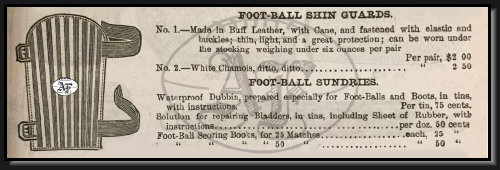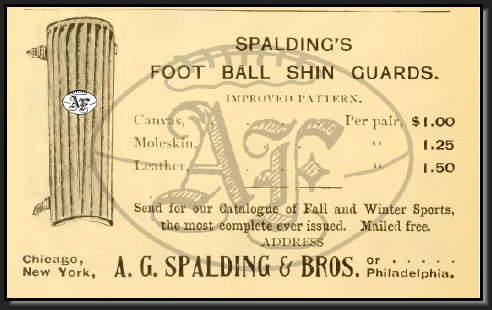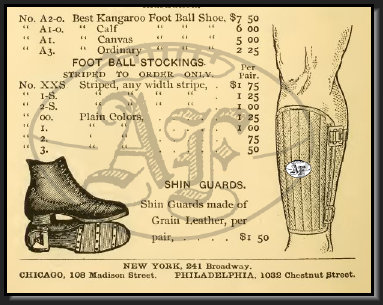
For millennia shin guards existed exclusively in the realm of the warrior. Designed to protect a soldier's lower leg, the shin guard is believed to have first been employed by the Greeks or Romans over 3,000 years ago. The use of shin guards in athletics originated with the sport of cricket in the early 1800's, when large cane ribbed pads were developed to protect the knees and legs of batsmen attempting to block a 100 mph hard leather ball from striking the stumps. The first documented use of shin guards in English football (soccer) occurred in 1874, when a former cricketer, Sam Weller Widdowson, fashioned a cut down version of his cricket pads to wear on the outside of his socks during a game.








1892 Yale Football Team showing most players wearing shin protection
American Made
Imported for American Sport
Chris Hornung
November 27, 2017
November 27, 2017
Football Shin Guard Evolution

Wright & Ditson's Annual Illustrated Catalogue, 1884

The earliest known reference to American football shin guards is a Peck & Snyder advertisement found in Wright & Ditson's 1882 publication of Walter Camp's American Intercollegiate Association's Foot-Ball Rules. Shin guards may have been offered in earlier Peck & Snyder catalogs, which were first published in 1871, but these reference materials were not available for inspection for this article.
By 1884, both Peck & Snyder (New York) and Wright & Ditson (Boston) were advertising foot ball shin guards and curiously used the identical images and descriptions in their catalogs. A likely explanation for this is that both dealers were importing shin guards from the same distributor in England or purchasing from the same importer, who provided them each the same printing block. Designed for use in both Association football (soccer) and Rugby football, the imported guards consisted of a buff or chamois leather body with cane reed inserts and elastic straps secured with buckles or two-prong clasps.
By 1884, both Peck & Snyder (New York) and Wright & Ditson (Boston) were advertising foot ball shin guards and curiously used the identical images and descriptions in their catalogs. A likely explanation for this is that both dealers were importing shin guards from the same distributor in England or purchasing from the same importer, who provided them each the same printing block. Designed for use in both Association football (soccer) and Rugby football, the imported guards consisted of a buff or chamois leather body with cane reed inserts and elastic straps secured with buckles or two-prong clasps.
Peck & Snyder's Price List of Out & Indoor Sports & Pastimes, 1886
Early shin guards were designed to be worn under the stocking, making photographic evidence of their use, and documentation of their popularity in the 1870's and 1880's, scarce. However, given the prevalent style of play, it is likely that linemen in particular would have worn shin guards during this time period. Nineteenth century football games consisted of a series of "scrummages" in which the ball was placed in the center of a mass of players who each attempted to kick the ball forward towards their opponents goal, or backwards to their "backs". A player's shins would be very vulnerable in the melee, particularly once bars and cleats were added to football shoes. By the early 1890's, shin guards were more common on the football field, but still not considered standard equipment. In his "An Introductory Chapter for Beginners" in the 1893 Spalding Intercollegiate Foot Ball Guide, Walter Camp stated:
Closeup showing white chamois shin guards
Closeup showing players with A) buff leather guard outside of stocking, B) guard beneath stocking, and C) thick wool socks with no guard
A
B
C


A.G. Spalding's Inter-Collegiate Football Guide, 1892
A.G. Spalding's Inter-Collegiate Football Guide, 1893
c.1890 buff leather shin guards with riveted leather straps
During the 1890's, the increased popularity of football shin guards is evidenced by the preponderance of players wearing them in team photographs. This growth in popularity also coincided with the rise of American sporting goods companies who relentlessly promoted the benefits of sports and, not surprisingly, the essential equipment for participants.
It is unknown when American sporting goods companies first began to manufacture shin guards domestically, but it is probable that it occurred in the early 1890's, the same period in which A.G. Spalding began to produce its own footballs. Up until that point, American football shin guards were indistinguishable from soccer and rugby guards sold by British manufacturers. In 1893, A.G. Spalding introduced an "improved pattern" shin guard that was available in leather for $1.50 per pair, and two lower grade materials, moleskin ($1.25) and canvas ($1.00). Both materials would be used repeatedly as lesser expensive alternatives to leather in lower grade head harnesses and pads through the 1920's. It is likely that this material divergence signifies the start of domestic production of shin guards in the United States.
It is unknown when American sporting goods companies first began to manufacture shin guards domestically, but it is probable that it occurred in the early 1890's, the same period in which A.G. Spalding began to produce its own footballs. Up until that point, American football shin guards were indistinguishable from soccer and rugby guards sold by British manufacturers. In 1893, A.G. Spalding introduced an "improved pattern" shin guard that was available in leather for $1.50 per pair, and two lower grade materials, moleskin ($1.25) and canvas ($1.00). Both materials would be used repeatedly as lesser expensive alternatives to leather in lower grade head harnesses and pads through the 1920's. It is likely that this material divergence signifies the start of domestic production of shin guards in the United States.
A.J. Reach & Co. No. 6 Canvas Shin Guards, c. 1902-1927
Benetfink & Company's Sports and Games Catalogue, Cheapside England, 1899, showing British guards with continuous straps and ankle guard variants
A.J. Reach & Co. Fall & Winter Catalog, 1902
American football shin guard design remained relatively unchanged through the 1890's until the early 1900's. Meanwhile, British manufacturers added features to their guards that would later be adopted by their American counterparts, including continuous straps and ankle guards.
1900 Team photo enlargement showing players wearing cane rib shin guards
"Long woolen stockings are worn, and occasionally, but not usually, shin guards by men playing in the forward line."
